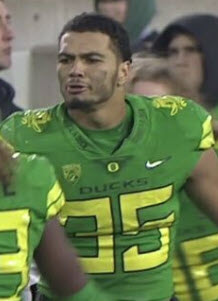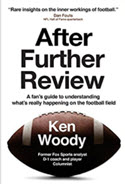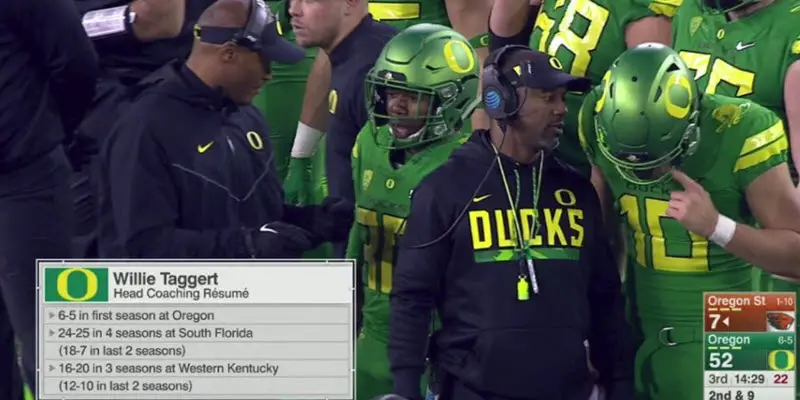First-year coach Willie Taggart got with the spirit of the 121st Civil War and personally led the Ducks to a 69-10 massacre over the hapless Oregon State Beavers at Autzen Stadium. Taggart had no pity on OSU, even calling a time out right before halftime to ice a kicker who was attempting a 47-yard field goal with the Beavers down, 52-7. Coach said later he didn’t want the Beavers to get any more points, which suited a sellout crowd of mostly Ducks who had to put up with a year’s worth of abuse for the Ducks’ 34-24 disaster last year in Corvallis.
In this example above, the first play of the game, the offensive line fires off in a zone-blocking scheme to the left, ahead of Royce Freeman, aligned in a pistol formation behind Justin Herbert. Herbert fakes the sweep to Freeman and rolls out to his right on a naked bootleg. The H-back, Jacob Breeland (No. 27) sneaks from behind the left tackle to the right flat at two yards deep. He freezes the outside linebacker who must hang there until he is sure there is no run coming back at him. If he did rush the quarterback, Herbert would dump the ball to Breeland.
The backside receiver on the left crosses the middle at eight yards and because there is only one linebacker to the right side in position, offers Herbert a choice between him and the H-back. The outside receiver on the right runs a stop route eight yards deep along the sideline and presents Herbert a choice between him and the slot that is running an outside seam route.
Herbert chooses the split end, wide open, and furthest from any defender. Notice how the pass causes the receiver to have to bend down and catch it—the ball was not thrown with enough zip on it. Herbert has a tendency to not square his body to his target when throwing on the run, and you can see after the release he is headed towards the sideline and not “running behind the ball,” which is a fundamental for throwing direct, accurate passes on the run.
Many times you will see a right-hander throwing across his body and the ball will fade, short, and out of bounds to the right; while throwing to his left, the ball will fade back toward the right, also with poor velocity.
The Beavers have problems from the start of this play above: grossly misaligned on the Ducks’ offensive formation, which allows the right offensive tackle and guard to easily hook the defenders to their side. The slot receiver does an excellent job of tying up the safety and the H-back blocks the outside linebacker.
This is an outstanding example of zone blocking: watch the offensive linemen running together laterally to their left, shoulder to shoulder, pushing their defenders ten yards downfield, testimony to good blockers and poor defenders who can’t get penetration before Freeman rolls for 13 easy yards.
The Duck defense has a good three-man pass rush and on this example above, defensive end Jalen Jelks (No. 97) gets good push and his hand up to rattle the quarterback tying up the left tackle while the nose man engages the center. Troy Dye (No. 35) rushes on a delayed rush after he decides that the quarterback is looking to throw to Dye’s right and comes through the guard-tackle gap, timing his leap to block the pass. Good pass defense begins on the line of scrimmage and this deflection may have prevented a third-down conversion or long completion.
In a closer look at this play, check out the power of freshman nose guard Jordon Scott (No. 34) who is driving the center and left guard back into the pocket, and because he does occupy those two linemen, opens up a lane for Dye to quickly get in the face of the quarterback and knock down the pass.
Later in the game, on a similar play where the quarterback was hurried and had a pass tipped at the line of scrimmage, Justin Hollins picked off the ball and ran it in for an 11-yard touchdown. Good pass defense starts at the line of scrimmage.
Watch the teamwork of the offensive line as they afford Herbert perfect protection for this touchdown throw. Their pad level is excellent, as are their stances and footwork: notice the guards and tackles have their outside foot back to maintain the integrity of the cup protection. The linemen are patient, with their eyes up and don’t overextend at the rushers who are executing a twist pass rush stunt—you can see the offensive linemen have zone blocking responsibilities because they don’t chase the twisters—this is also reason most pass blocking is zone, as they would be running into each other trying to stay with their man.
Their hands are stretched to each side, to stay in the proper spatial relationship with the lineman next to them, and is a form of communication and discipline with his mates on either side: to maintain awareness of their blocking responsibilities. The left guard has his head on a swivel, gauging where he needs to help: ultimately the center.
Herbert looks to his left, which influences the safety on the H-back (Breeland No. 27) going down the middle. He is almost too late throwing the ball to his split receiver who makes a wonderful catch just an inch inside the end line of the end zone. If Herbert can get this kind of protection on a regular basis, the sky is the limit.
The Ducks Will Bowl, Probably in Phoenix?

Troy Dye
You must credit Willie Taggart with an outstanding job of keeping his team and coaching staff on even footing in the middle of the season when Herbert was injured, the offense was impotent and the defense beleaguered. In his first year on the job, Taggart’s staff steadily improved the quality of play on both sides of the ball—the most dramatic being that of the defense, which was awful last season.
There were many players with limited skills who took their games to new levels, a credit to the coaching of Taggart’s assistants. The reward will be a bowl game and an opportunity to further sell the Duck program to the rest of the country and hopefully, to many top-flight recruits.
Taggart’s only failure was the inability of the coaches to change the penalty culture that dogs the Ducks nearly every game. At the end of the season, Oregon was the worst team in the country accumulating penalty yardage (the only one to get more than 1,000 yards in flags). The second-worst was Taggart’s previous team at South Florida.
One would hope that this is not just a Taggart Problem; it will be interesting to see if the coaches can find a way to change this lack of discipline and hope it doesn’t spill over into other areas of the program.
Retired College Coach Ken Woody
Eugene, Oregon
Top Photo: From Video
My friends–I highly suggest Ken’s book as it makes a great Christmas gift for fans who want to learn and enjoy more of their Duck Football Experience. Mr. FishDuck
Mike Bellotti, ESPN analyst and Former-Oregon coach: “Ken Woody’s ability to break down the game with interesting, entertaining insights comes from a career as a college player and coach, influenced by some of the top coaches in football. Woody spells it out in a simple, refreshing, humorous manner.”
 Buy the book here to learn from Coach Woody, or give a gift of football.
Buy the book here to learn from Coach Woody, or give a gift of football.
Dan Fouts, NFL Hall of Fame, Oregon Ducks quarterback: “Entertaining and easy to understand.”
“Every Oregon fan should have a copy to learn from as I do.” Charles Fischer
Ken Woody is a former Fox Sports football commentator who played defensive back, receiver and kicker for Oregon from 1966 to 1970. He coached college football for 18 years, including stints as an assistant coach at Oregon, Washington, Washington State and Utah State, and was head coach at Whitman College and Washington University-St. Louis.
Related Articles:
Seven Offensive Coordinator Candidates for the Oregon Ducks
Five Candidates to Replace OC Marcus Arroyo
Coach Jim Mastro: The Perception, and the Truth
Has Oregon Turned the Corner on Offense?
Textbook Defense, Herbert's Return Energize Duck Victory; Civil War Next
Ducks (Coaches and Players) Need to Focus Against Arizona
“I learned football working under many great coaches, among them Len Casanova, Jerry Frei, John Robinson, Bruce Snyder, George Seifert,and Ron Stratten at the University of Oregon, Jim Owens at the University of Washington and Jim Walden at Washington State University. Most of my coaching experience was on the offensive side of the ball with quarterbacks, receivers and kickers although as a head coach I coached defensive backs, linebackers and offensive line.
I achieved my first goal of being the youngest head coach in college football at the age of 26 and throughout my career in coaching and outside of it, as a journalist and broadcaster, have experienced how exciting and gratifying it is teaching the game to others.”

